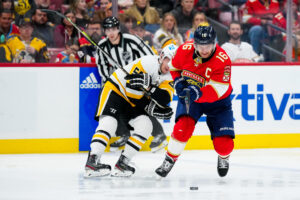Welcome to Last Word on Hockey’s 2021 NHL Draft Class introductions. The 2020 Draft class was a blast, and the 2021 NHL draft should be too. Alexis Lafreniere was the first overall pick for the New York Rangers in ‘20, but who will it be in ‘21? How about we here at Last Word introduce two names to pay attention to this season: Nikita Chibrikov and Prokhor Poltapov.
2021 NHL Draft Class Introductions: Who To Watch This Season
Russian hockey has always been a powerhouse. It is no surprise that the NHL has seen their fair share of Russian superstars, like Alex Ovechkin and Nikita Kucherov. Over the last two drafts, Vasily Podkolzin, Yaroslav Askarov and Rodion Amirov were selected early, continuing to infuse the NHL with Russian machines. Arguably the top two Russians in 2021 are Nikita Chibrikov and Prokhor Poltapov.
Nikita Chibrikov
Chibrikov, born February 16th, 2003, in Moskva, Russia, is a 17-year-old right-winger. Standing at 5’10” and 161 pounds, the left handed winger is a bit slight in size. He has found himself ranked 11th in the 2021 NHL Draft by Neutral Zone, 16th by Recruit Scouting, 17th by Smaht Scouting, 20th by Dobber Prospects, 24th by The Puck Authority, and 25th by Future Considerations and Draft Prospects Hockey. Last Word on Hockey has Chibrikov ranked 15th in our current 2021 NHL Draft rankings, and the top-ranked prospect out of Russia.
So far this season, Chibrikov has played all three levels of Russian hockey. Starting in the MHL, Chibrikov posted three goals and five assists for eight points in nine games. He followed that up with one goal and four assists for five points in 13 VHL games. Finally, in arguably the second-best hockey league in the world, he has played 12 KHL games, with one goal and one assist for two points.
Nikita Chibrikov’s Overall Game
Chibrikov wouldn’t be a highly-touted prospect if it wasn’t for his skating ability. His game is based on his speed. He has a smooth stride, as he effortlessly moves up ice. His edge work is fluid, and he has the ability to weave through opposing players. Chibrikov pairs his skating with his stickhandling abilities and creativity. Those qualities make him one of the better transitional players in the draft.
Transitional Stats
Chibrikov, in an MHL game I tracked, was involved often in transition. As an example, in the same league, he had more direct impact in one period of play than Daniil Lazutin, another 2021 NHL draft eligible, did in an entire game. Chibrikov directly impacted seven zone exits in that game. Of those seven, three were cleared with possession, two were dumped out, and two failed to exit the zone.
When it came to entering the zone, Chibrikov’s skills came to life. Involved directly in 11 zone entries, he carried all five entries with possession himself. Of the remaining six entries, four were dumped in and two failed to gain entry.
Chibrikov came through with several dazzling plays. Outside of the one game I tracked, it’s clear that he thrives off the rush, making his creativity, stickhandling, confidence, and skating when on the transition is all the more important.
Offensive Game
As stated above, Chibrikov thrives offensively because of his transitional skills. Outside of that, he does not possess necessarily strong passing or shooting abilities. He is a smart shooter, throwing shots low for rebounds or tips. He owns a quick release and the ability to change the angle on his release. Oftentimes, he will open his hips and perform a toe drag, then release the shot from that spot. This quick move opens up a lane, as defenders don’t always adjust fast enough to get in front of the shot. However, Chibrikov’s shot doesn’t have NHL-level power, and inconsistent accuracy.
His passing ability relies on IQ and anticipation more than skill. Having the ability to facilitate the play, he can change the pace when he has the puck. There are times where he can flash his playmaking skills, but that is not a consistent theme in his game.
As mentioned earlier, Chibrikov is a strong skater. That said, he tries to be effective through his skating, by forechecking aggressively and backchecking hard. However, just because he forechecks hard does not mean he is always aggressive. Per InStat Hockey, Chibrikov has gotten involved in 9 puck battles per game this season, which is slightly below average. He has won those puck battles at a 42 percent clip in those battles, which is also about average for Russian forwards.
Offensive Numbers
In the one game I tracked, his pass-first mentality shined through. Chibrikov had six offensive zone pass attempts, and completed five of them. He was two-for-two on simple passes, two-for-two on cross-ice passes, one-for-one on cycle passes and zero-for-one on centering passes. His ability to be effective and accurate while also attacking through various passing lanes exemplifies his underlying playmaking abilities.
When it comes to his shot, he fired just three attempts towards the net, with one actually landing on net. Of those three shot attempts, two came from the perimeter and one from the slot, with the one shot on goal coming from the perimeter. According to InStat, he fires 3.6 shots per game with 60% hitting the net. Also according to InStat, 68 of his 124 total shot attempts this season have come from the low, medium and high slot areas, showing his ability to attack through the middle with his shots.
Defensive Game
Chibrikov is not a bad defensive forward. He also isn’t that great. To put that into perspective, he will probably bring the same value to the defensive end of the ice as an Alexander Radulov, who checked in with a 0.7 Even-Strength Defense rating last season. He won’t be a negative player, but his value certainly won’t come from his defensive game.
He supports his teammates down low and against the cycle, but the lack of aggressiveness I touched on earlier, plus his small stature, limit his ability to defend against the cycle. On top of that, he looks uninterested at times. He’ll float around and not move his feet very often when defending. What he does do well, is keep his head on a swivel. Chibrikov does not usually get caught puck-watching or puck-chasing, instead looking over his shoulder to make sure his man does not sneak into space behind him.
Prokhor Poltapov
Born February 1st, 2003, in St. Petersburg, Russia, is a left-handed right winger, like Chibrikov. Standing at 5’10” and 161 pounds, he’s also the same size as Chibrikov. Unlike his Russian counterpart, however, he’s only ranked in the top-25 by one outlet, Neutral Zone, where he is ranked 12th. He has also been ranked 32nd by Recruit Scouting and Draft Prospects Hockey, 49th by Future Considerations, and 60th by Dobber Prospects. In my personal rankings, Poltapov is listed at 24th.
Last season, playing in the MHL, Poltapov recorded eight goals and four assists for 12 points in 23 games. This season, he has blown those totals away. Scoring 17 goals and 16 assists for 33 points in 43 games, Poltapov could get at least a small opportunity to play in the KHL sooner rather than later, if he keeps it up.
Prokhor Poltapov’s Overall Game
Poltapov and Chibrikov are both extremely similar players. Poltapov is a lesser skater and does not drive play through the transition nearly as well as Chibrikov does. However, he is more aggressive and gets involved in battles more consistently. Despite being the same size as his Russian counterpart, Poltapov looks stronger, as he throws his weight around more efficiently. His awareness while playing aggressive is also high-end, as he outsmarts his opponents while attacking them. Poltapov is also more aggressive when it comes to moving the puck. Also, Poltapov shoots more than Chibrikov does, so he is all-in-all a more aggressive offensive player. Defensively, they’re about even, but Poltapov cheats up ice more while maintaining a strong active stick.
Transitional Stats
In the one game I tracked on Poltapov, he was directly involved in five zone exit attempts. Of those five, two were cleared with possession, one was cleared without possession, and two failed to get out of the zone. It’s clear that Poltapov’s style of cheating up ice to generate offense limits his breakout effectiveness.
Poltapov was directly involved in 11 zone entries. Of those 11, seven entered with possession, one entered without possession, and three failed to gain entry. While he was just as involved as Chibrikov when moving the puck into the offensive zone, he doesn’t generate as much offense through it. He’s also less effective than Chibrikov is, which is indicative of his three fails. A combination of lesser skating and puck-handling abilities, as well as lower puck carrier vision and awareness, makes Poltapov a less effective transitional player. He is still reliable and effective, but there is a clear line separating him and Chibrikov.
Offensive Numbers
Sticking to the one game I tracked, Poltapov completed 10-of-13 pass attempts in the offensive zone. Of those pass attempts, he went five-for-five on simple passes, four-for-six on centering passes, zero-for-one on cross-ice passes and one-for-one on cycle passes. The key stat to look at here is his four-for-six mark on centering passes. There were several occasions where he would skate behind the opposing net and send a puck right out front to a teammate. He showed strong vision and solid passing accuracy on those plays.
For his shooting, Poltapov had three shot attempts, with one shot on goal. That one shot on goal happened to find the back of the net. His shot attempts all came from the slot. On the season, via InStat, Poltapov has 190 total shot attempts, and of those, 116 have come from the low-to-mid slot area. His ability to get his shots from those high-danger areas at a consistent basis is fantastic, and shows why he has racked up 18 goals on the year.
To go back on his aggressiveness mentioned earlier, Poltapov gets involved in 15 puck battles per game, according to InStat. He also averages 0.86 hits per game. That’s better than Chibrikov’s nine puck battles per game.
Overall
Chibrikov and Poltapov are fairly similar players. While Chibrikov is the more well-rounded player, Poltapov is the much more aggressive of the two offensively, and physically. Of the two, Chibrikov’s game is the more projectable, with his strong skating and transitional abilities. However, keep an eye on Poltapov. His playmaking abilities are better than the stats show, and his ability to get into the high-danger areas and score consistently from them is key.
Main Photo:






